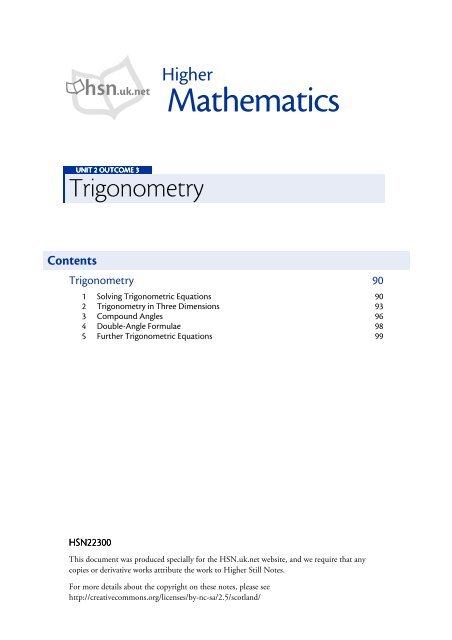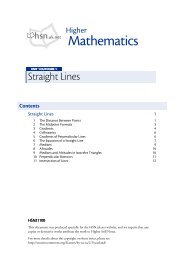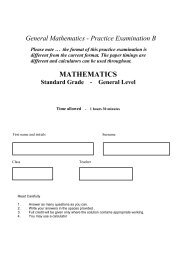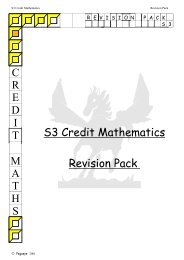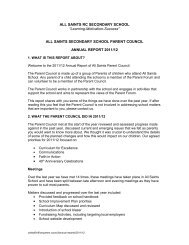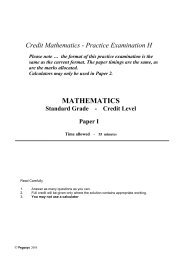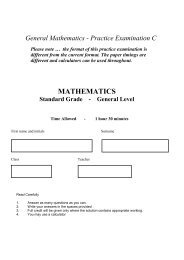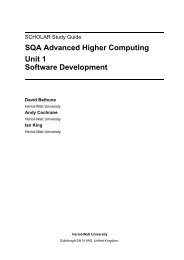Trigonometry
Trigonometry
Trigonometry
You also want an ePaper? Increase the reach of your titles
YUMPU automatically turns print PDFs into web optimized ePapers that Google loves.
hsn.uk.netHigherMathematicsUNIT 2 OUTCOME 3<strong>Trigonometry</strong>Contents<strong>Trigonometry</strong> 901 Solving Trigonometric Equations 902 <strong>Trigonometry</strong> in Three Dimensions 933 Compound Angles 964 Double-Angle Formulae 985 Further Trigonometric Equations 99HSN22300This document was produced specially for the HSN.uk.net website, and we require that anycopies or derivative works attribute the work to Higher Still Notes.For more details about the copyright on these notes, please seehttp://creativecommons.org/licenses/by-nc-sa/2.5/scotland/
Higher Mathematics Unit 2 – Mathematics 24. Solve tan x° = − 5 for 0 < x < 360 .Notetan x° = − 5180° − x° x°̌ S AT C ̌180° + x° 360° − x°−1x = tan ( 5)= 78·690 (to 3 d.p.)x = 180 − 78·690 or 360 − 78·690x = 101·310 or 281·310Since tan x° is negativeAll trigonometric equations in Higher can be reduced to problems like thoseabove. The only differences are: the solutions could be required in radians – in this case, the question willnot have a degree symbol, e.g. Solve 3tan x = 1 rather than 3tan x° = 1 exact value solutions could be required in the non-calculator paperQuestions can be worked through in degrees or radians, but make sure thefinal answer is given in the units asked for in the question.EXAMPLES5. Solve 2sin2x° − 1 = 0 where 0 ≤ x ≤ 360 .2sin2x° = 1180° − 2x° 2x°̌ S A ̌ 0 ≤ x ≤ 360sin2x° = 12T C 0 ≤ 2x≤ 7202x = 30 or 180 − 30180° + 2x° 360° − 2x°2x= sin= 30or 360 + 30 or 360 + 180 − 30or 360 + 360 + 302x= 30 or 150 or 390 or 510x = 15 or 75 or 195 or 255−( )1 12NoteThere are more solutionsevery 360°, sincesin(30°) = sin(30°+360°) = …So keep adding 360 until2x > 720hsn.uk.netPage 91HSN22300
Higher Mathematics Unit 2 – Mathematics 26. Solve 2 cos2x = 1 where 0 ≤ x ≤ π .cos2x = 1 π − 2x2x2S A ̌T C ̌2 x = π or 2π− π4 4or 2π+ π42 x = π or7π4 4x = π 78 or π87. Solve24cos x = 3 where 0 < x < 2π.( cos x ) 2 = 34cos x = ± 34cos x = ±32π + 2x2π− 2x2x= cos= π4−( )1 120 ≤ x ≤ π0 ≤ 2x≤ 2π̌ S A ̌ Since cos x can be positive or negativě T C ̌x = cos= π6−( )1 32x = π6or π − π6or π + π6or 2π− π6or 2π+ π6x = π 5 7 116orπ6orπ6or π68. Solve 3tan( 3x° − 20° ) = 5 where 0 ≤ x ≤ 360 .3tan( 3x° − 20° ) = 5tan( 3x° − 20° ) = 53S A ̌̌ T C0 ≤ x ≤ 3600 ≤ 3x≤1080−20 ≤ 3x− 20 ≤1060( )−1 3x− 20 = tan53= 59·036 (to 3 d.p.)3x − 20 = 59·036 or 180 + 59·036or 360 + 59·036 or 360 + 180 + 59·036or 360 + 360 + 59·036 or 360 + 360 + 180 + 59·036or 360 + 360 + 360 + 59·0362π31π632π41π41hsn.uk.netPage 92HSN22300
Higher Mathematics Unit 2 – Mathematics 23x− 20 = 59·036 or 239·036 or 419·036or 599·036 or 779·036 or 959·0363x= 79·036 or 259·036 or 439·036or 619·036 or 799·036 or 979·036x = 26·35 or 86·35 or 146·35 or 206·35 or 266·35 or 326·359. Solve ( x π3 )( x π)cos 2 + = 0·812 for 0 < x < 2π.cos 2 + 3 = 0·812 S A ̌0 < x < 2πT C ̌0 < 2x< 4ππ < + π < π + π3 2x3 4 31·047 < 2x+ π3 < 13·614 (to 3 d.p.)12x π −+ 3 = cos ( 0·812 )RememberMake sure your= 0·623calculator uses radians2x+ π3 = 0·623 or 2π− 0·623or 2π + 0·623 or 2π + 2π− 0·623or 2π + 2π + 0·623 or 2π + 2π + 2π− 0·6232x+ π . . . .3 = 5 660 or 6 906 or 11 943 or 13 1892x= 4. 613 or 5. 859 or 10. 896 or 12.142x = 2. 307 or 2. 930 or 5. 448 or 6.0712 <strong>Trigonometry</strong> in Three DimensionsSolving problems in three dimensions uses the same techniques as in twodimensions. The use of sketches in solutions to these problems is advised.The angle between a line and a planeThe angle a between the plane P and the line ST is calculated by drawing aline perpendicular to the plane and then using basic trigonometry.TPaShsn.uk.netPage 93HSN22300
Higher Mathematics Unit 2 – Mathematics 2EXAMPLE1. The triangular prism ABCDEF is shown below.EA10 cmCalculate the acute angle between:(a) The line AF and the plane ABCD.(b) AE and ABCD.(a) Start with a sketch:Oppositetana=Adjacent=3101(3 )−Aa = tan10 cm D10= 16. 699 ° (or 0.291 radians) (to 3 d. p .)NoteSince the angle is in a right-angled triangle, it must be acute (i.e. lie inthe first quadrant) and therefore we do not use a CAST diagram.(b) Again, make a sketch:b angle to beAcalculatedWe need to calculate the length of AC first using Pythagoras’s Theorem:C2 2AC = 10 + 66 cmA= 13610 cm DTherefore:EOppositetanb=3 cm Adjacent= 3C136AabF136 cmB3 cmE3 cmCFDC6 cm3 cm1 3( )−b = tan136= 14. 426 ° (or 0.252 radians) (to 3 d. p .)hsn.uk.netPage 94HSN22300
Higher Mathematics Unit 2 – Mathematics 2The angle between two planesThe angle a between planes P and Q is calculated by drawing a lineperpendicular to Q and then using basic trigonometry.PQaEXAMPLE2. ABCDEFGH is a cuboid with dimensions 12 × 8× 8 cm as shown below.HGEF8 cm8 cmA 12 cm B(a) Calculate the size of the angle between the planes AFGD and ABCD.(b) Calculate the size of the acute angle between the diagonal planesAFGD and BCHE.(a) Start with a sketch:FAa12 cm8 cmBDOppositetana=Adjacent=8121(2 )CNoteAngle GDC is the samesize as angle FAB−a = tan 3= 33. 690 ° (or 0.588 radians) (to 3 d. p .)(b) Again, make a sketch:EFTA• •BLet AF and BE intersect at T ATB is isosceles, so TAB = TBA ɵ = 33.690 °ATB = 180° − ( 33. 690° + 33.690°)= 112.620°NoteThe angle could alsohave been calculatedusing rectangle DCGHSo the acute angle is:BTF = ATE = 180° − 112.620°= 67. 380 ° (or 1.176 radians) (to 3 d. p .)hsn.uk.netPage 95HSN22300
Higher Mathematics Unit 2 – Mathematics 23 Compound AnglesWhen we add or subtract angles, we call this a compound angle.For example, 45° + 30° is a compound angle. Using a calculator, we find:• sin( 45° + 30° ) = sin( 75° ) = 0.966• sin( 45° ) + sin( 30° ) = 1.207 (both to 3 d.p.).This shows that sin ( A + B ) is not equal to sin A + sin B . Instead, we canuse the following identities:sin( A + B ) = sin Acos B + cos AsinBsin( A − B ) = sin Acos B − cos AsinBThese are given in the exam in a condensed format:sin( A ± B ) = sin Acos B ± cos AsinBEXAMPLEScos( A ± B ) = cos Acos B ∓ sin AsinB1. Expand and simplify cos( x° + 60° ) .cos( x° + 60° ) = cos x° cos60° − sin x° sin60°2. Show that ( )cos( A + B ) = cos AcosB − sin AsinBcos( A − B ) = cos AcosB + sin AsinB1 3= 2 cos x° − 2 sin x°sin a + b = sina cosb + cos a sinbfor a = π6and b = π3 .LHS = sin( a + b)RHS = sin a cosb + cosa sinb= sin π π( 6+= sin π3 )6cos π3 + cos π6sin π33 3= sin π1 1( 2 )= ( 2 × 2 ) + ( 2 × 2 )= 1= 1 34+ 4= 1Since LHS = RHS , the claim is true for a = π6and b = π3 .3. Find the exact value of sin75° .( )sin75° = sin 45° + 30°= sin 45° cos30° + cos45° sin30°1 3 1 1( 2 ) ( 2 )= × + ×2 2=3+ 12 2 2 23=+ 12 2=6+24hsn.uk.netPage 96HSN22300
Higher Mathematics Unit 2 – Mathematics 2Finding Trigonometric RatiosYou should already be familiar with the following formulae (SOH CAH TOA).Oppositesin a =HypotenuseAdjacentcosa =HypotenuseOppositetana =AdjacentpIf we have sin a = q where 0 < a < π2 , then we can form a right-angledtriangle to represent this ratio.Opposite pSince sin a = = q then:qHypotenusep the side opposite a has length pa the hypotenuse has length qThe length of the unknown side can be found using Pythagoras’s Theorem.Once the length of each side is known, we can find cosa and tana usingSOH CAH TOA.The method is similar if we know cosa and want to find sin a or tana .EXAMPLEHypotenuseaAdjacentOpposite4. Acute angles p and q are such that sin p = 45 and sinq = 513 . Show thatsin 63( p + q) = 65.5 4p3sin p = 45cos p = 35q13125sinq = 513cosq = 1213( )sin p + q = sin pcosq + cos psinq4 12 3 5( ) ( )= 5 × 13 + 5 × 13= 48 +1565 65= 6365(as required)NoteSince “Show that” is usedin the question, all ofthis working is requiredThis is a common exam question.hsn.uk.netPage 97HSN22300
Higher Mathematics Unit 2 – Mathematics 2Using compound angle formulae to confirm identitiesEXAMPLES5. Show that sin( x π2 )sin π( x − )− = − cos x .2= sin x cos π − π2 cos x sin 2= sin x × 0 − cos x ×1= −cosx (as required)sin( s + t )6. Show that = tan s + tantfor cos s ≠ 0 and cost ≠ 0.cos s costsin( s + t ) sin s cost + cos s sint=cos s cost cos s costsin s cost cos s sint= +cos s cost cos s costsin s sint= +cos s cost= tan s + tan t (as required)Remembersin x= tan xcos x4 Double-Angle FormulaeIf we use the compound angle identities with A = B , then we obtainexpressions for sin2A and cos2A . These are called double-angle formulae.sin2A = 2sin AcosAcos2 cos sin2 2A = A − A= −22cos A 1= 1−2sinIt is important to remember that these are given in the exam.EXAMPLEGiven tanθ = 43 for acute angle θ , find the exact value of sin2θ and cos2θ.2A5 4θ3sinθ = 43cosθ = 35sin2θ = 2sinθ cosθ= 2 × 4 35×5= 24252 2θ = θ − θcos2 cos sin3 4( ) ( )2 2= 5 − 5= 9 1625 − 25= − 725NoteAny of the cos2Aformulae can be used inthis examplehsn.uk.netPage 98HSN22300
Higher Mathematics Unit 2 – Mathematics 25 Further Trigonometric EquationsWe will now consider trigonometric equations where the double-angleformulae are used to find solutions. These equations will involve: sin2x and either sin x or cos x cos2x and cos x cos2x and sin xSolving equations involving sin2x and either sinx or cosxEXAMPLE1. Solve sin2x° = − sin x° for 0 ≤ x < 360 .2sin x° cos x° = − sin x°2sin x° cos x° + sin x° = 0sin x° = 0sin x° ( 2cos x° + 1)= 02cos x° + 1 = 0 Replace sin2x using the double angleformula Take all terms to one side, making theequation equal to zero Factorise the expression and solvex = 0 or 180 or 360 cos x° = − 12x = 180 − 60 or 180 + 60So x = 0 or 120 or 180 or 240 .Solving equations involving cos2x and cosxEXAMPLE2. Solve cos2x= cos x for 0 ≤ x ≤ 2π.= 120 or 240RememberThe double-angleformulae are given inthe exam̌ S Ǎ T Cx = cos= 60−( )1 12cos2x= cos x22cos x − 1 = cos22cos x cos x 1 0− − =( 2cos x + 1)( cos x − 1)= 02cos x + 1 = 0cos x = − 12x = π − π3 or π + π3= 2π43 or π3So x = 0 or 2π 43 or π3 or 2π.x Replace cos2x by22cos x − 1 Take all terms to one side, making aquadratic equation in cos x Solve the quadratic equation (usingfactorisation or the quadratic formula)̌ S Ǎ T Cx = cos= π3−( )1 12cos x − 1 = 0cos x = 1x = 0 or 2πhsn.uk.netPage 99HSN22300
Higher Mathematics Unit 2 – Mathematics 2Solving equations involving cos2x and sinxEXAMPLE3. Solve cos2x= sin x for 0 < x < 2π.cos2x= sin x21− 2sin x = sin+ − =22sin x sin x 1 0( 2sin x − 1)( sin x + 1)= 0x Replace cos2x by21−2sin x Take all terms to one side, makinga quadratic equation in sin x Solve the quadratic equation (usingfactorisation or the quadraticformula)2sin x − 1 = 0sin x = 12x = π6or π − π6= π 56or π6So x = π 5 36or π6or π2 .̌ S A ̌T Cx = sin= π6−( )1 12sin x + 1 = 0sin x = −1x = 3π2hsn.uk.netPage 100HSN22300


